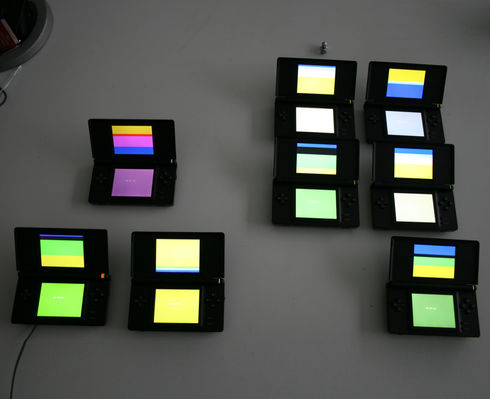chronoPrints
2009
LAb[au], Manuel Abendroth, Jérôme Decock, Els Vermang
Size: 60 x 60 cm and 110 x 110 cm
Technique: pigmentprint on D-bond
format
computer-generated prints with pseudo code
edition of 3
cycle AM or PM (12prints) : edition of 1
Complete cycle (24 prints) : edition of 1
format
as widget , the ChronoApp
as a real-ime illumination of the Dexia Tower, Brussels in 2007
history
2009 ___ time|emit, DAM Gallerie, Berlin, Berlin
2009 ___ Young Belgium Painters Award, Bozar, Brussels
2010 ___ From kinetic to digital art, Fondation Vasarely, Aix en Provence
2010 ___ West-Arch, Ludwig Forum, Aachen
2010 ___ Creativity World Biennale, Oklahoma
2011 ___ Tender Buttons, Overpoort, Gent
2013 ___ Poème Numérique, Atomium, Brussels
2014 ___ writing drawing painting, DAM Berlin, Berlin
2014 ___ Accrochage, Denise René rive gauche, Paris
2014 ___ zéro-un _ Galerie Denise René Rive Gauche, Paris
2015 ___ monoChrono, Liedts-Meesen Foundation, Gent,
2016 ___ calculations, permutations, notations, The Major Gallery, London
2016 ___ Langage Codé, La Patinoire, Brussels
2017 ___ Langage Codé, Fontana Gallery, Amsterdam
2019 ___ IF THEN ELSE, Casino Luxembourg, Luxembourg City
2022 / 23 Zeit Zeichen Zeichen Zeit, Kunstmuseum, Heidenheim
2024 ___ painting, writing, calculating, transcoding, Dan Galeria, Sao Paulo
![chronoPrints, LAb[au]](https://static.wixstatic.com/media/fb1d51_8fa7a99746e84e77942acea23993951a~mv2.jpg/v1/fit/w_994,h_460,q_90,enc_avif,quality_auto/fb1d51_8fa7a99746e84e77942acea23993951a~mv2.jpg)
![chronoPrints, LAb[au]](https://static.wixstatic.com/media/fb1d51_5ca7b5bc91434582a265267d8fe93489~mv2.jpg/v1/fit/w_1017,h_460,q_90,enc_avif,quality_auto/fb1d51_5ca7b5bc91434582a265267d8fe93489~mv2.jpg)
![chronoPrints, LAb[au]](https://static.wixstatic.com/media/fb1d51_2ec599c31a3b4cbeaaee61d42a9bdfb6~mv2.jpg/v1/fit/w_490,h_400,q_90,enc_avif,quality_auto/fb1d51_2ec599c31a3b4cbeaaee61d42a9bdfb6~mv2.jpg)
![chronoPrints, LAb[au]](https://static.wixstatic.com/media/fb1d51_84a6c99fcf004bb3aabe84f7299a8847~mv2.jpg/v1/fit/w_490,h_400,q_90,enc_avif,quality_auto/fb1d51_84a6c99fcf004bb3aabe84f7299a8847~mv2.jpg)
![chronoPrints, LAb[au]](https://static.wixstatic.com/media/fb1d51_254e131a335f410c9de961c01321823a~mv2.jpg/v1/fit/w_490,h_400,q_90,enc_avif,quality_auto/fb1d51_254e131a335f410c9de961c01321823a~mv2.jpg)
![chronoPrints, LAb[au]](https://static.wixstatic.com/media/fb1d51_c2b526284a0b497bbc8c042e571d18a6~mv2.jpg/v1/fit/w_490,h_400,q_90,enc_avif,quality_auto/fb1d51_c2b526284a0b497bbc8c042e571d18a6~mv2.jpg)




![chronoPrints, LAb[au]](https://static.wixstatic.com/media/fb1d51_5e4a36b6b89d4ccdaea8a0135f69bda7~mv2.jpg/v1/fit/w_490,h_400,q_90,enc_avif,quality_auto/fb1d51_5e4a36b6b89d4ccdaea8a0135f69bda7~mv2.jpg)
![chronoPrints, LAb[au]](https://static.wixstatic.com/media/fb1d51_5d60f3398a6d4ed8841f11cc34f02619~mv2.jpg/v1/fit/w_490,h_400,q_90,enc_avif,quality_auto/fb1d51_5d60f3398a6d4ed8841f11cc34f02619~mv2.jpg)
![chronoPrints, LAb[au]](https://static.wixstatic.com/media/fb1d51_0a1156edfcf74a3a8a4de403dba28c4f~mv2.jpg/v1/fit/w_490,h_400,q_90,enc_avif,quality_auto/fb1d51_0a1156edfcf74a3a8a4de403dba28c4f~mv2.jpg)
![chronoPrints, LAb[au]](https://static.wixstatic.com/media/fb1d51_8c344a0cb8c94bd3950375d539cefd31~mv2.jpg/v1/fit/w_490,h_400,q_90,enc_avif,quality_auto/fb1d51_8c344a0cb8c94bd3950375d539cefd31~mv2.jpg)